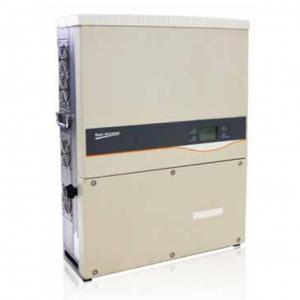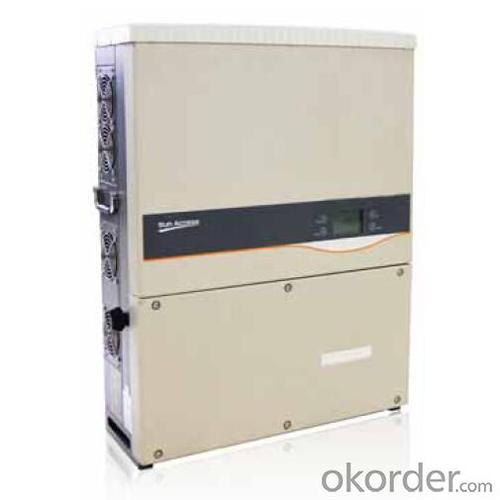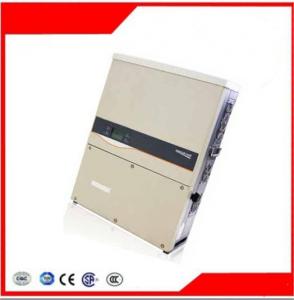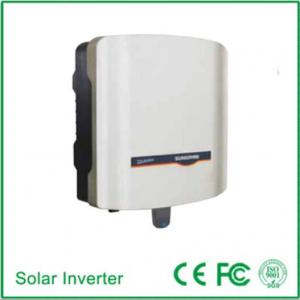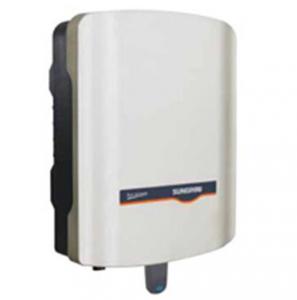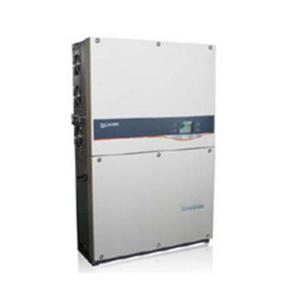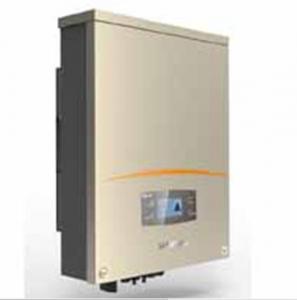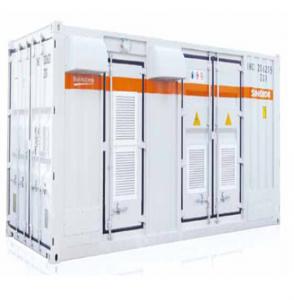250KW Solar Inverter Photovoltaic Grid-Connected Inverter SG40KTL
- Loading Port:
- China Main Port
- Payment Terms:
- TT or LC
- Min Order Qty:
- 50 unit
- Supply Capability:
- 10000 unit/month
OKorder Service Pledge
OKorder Financial Service
You Might Also Like
1. Structure of Photovoltaic Grid-Connected Inverter SG40KTL Description
A solar inverter, or PV inverter, or Solar converter, converts the variable direct current (DC) output of a photovoltaic (PV) solar panel into
autility frequency alternating current (AC) that can be fed into a commercial electrical grid or used by a local, off-grid electrical network.
It is acritical BOS–component in a photovoltaic system, allowing the use of ordinary AC-powered equipment.
Solar inverters have special functions adapted for use with photovoltaic arrays, including maximum power point tracking and anti-islanding protection.
Suitable for 50Hz/60Hz grid, could be used in Asia, Africa and Europe. Available for hand installation, no need for lifting machinery
assistance.
2. Main Features of the Photovoltaic Grid-Connected Inverter SG40KTL
• Full 36kW effective power at power factor of 0.9 due to apparent power reserves up to 39.8kVA
• Max. Efficiency at 98.3%
• Dual MPP trackers control
• Reduced cabling on AC side due to higher output voltage of 480Vac
• Integrated combiner box: 8 x MC4 connector pairs with DC string fuses, Type II overvoltage protection and DC switch, more safety and lower the system cost
• Can be wall-mounted without lifting equipment, weight 65 kg
• Active power continuously adjustable (0~100%)
• Reactive power control with power factor 0.8 overexcited ~ 0.8 underexcited
• Includes RS-485 interface, compatible with all common monitoring systems
• Product certification: TÜV, BDEW and CGC
• Manufacturer certification: ISO 9001, ISO 14001, OHSAS 18000
3. Photovoltaic Grid-Connected Inverter SG40KTL Images
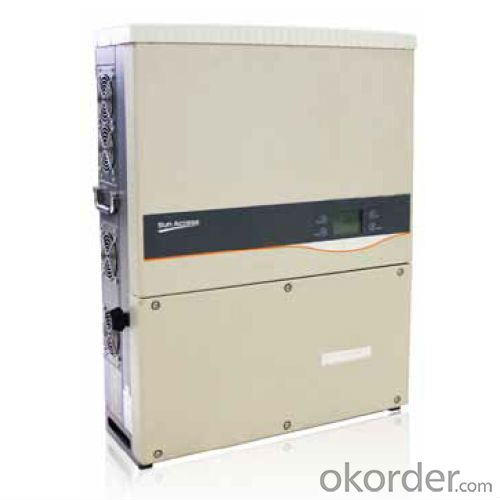
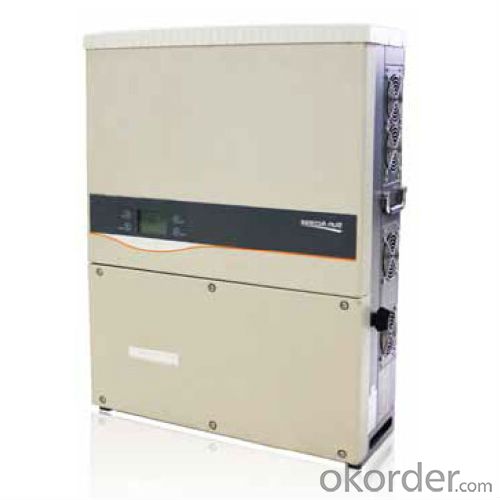
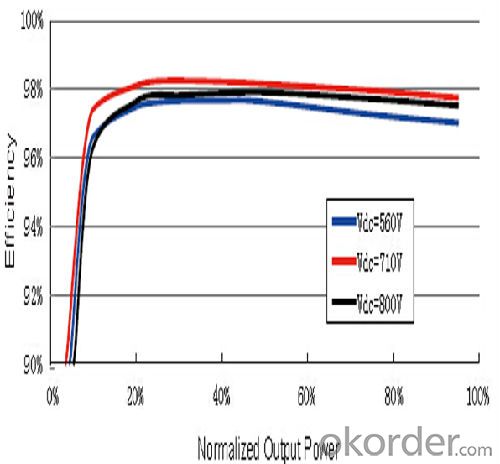
4. Photovoltaic Grid-Connected Inverter SG40KTL Specification
Input Side Data | |
Max. PV input power | 40500W |
Max. PV input voltage | 1000V |
Startup voltage | 300V |
Nominal input voltage | 710V |
MPP voltage range | 280~950V |
MPP voltage range for nominal power | 560~800V |
No. of MPPTs | 2 |
Max. number of PV strings per MPPT | 4 |
Max. PV input current | 66A(33A/33A) |
Max. current for input connector | 12A |
Output Side Data | |
Nominal AC output power | 36000W |
Max AC output power(PF=1) | 39800W |
Max. AC output apparent power | 39800VA |
Max. AC output current | 48A |
Nominal AC voltage | 3/N/PE, 277/480Vac or 3/PE, 480Vac |
AC voltage range | 422~528Vac |
Nominal grid frequency | 50Hz/60Hz |
Grid frequency range | 45~55Hz/55~ 65Hz |
THD | < 3 % (Nominal power) |
DC current injection | <0.5 %In |
Power factor | >0.99@default value at nominal power |
(adj. 0.8overexcited ~0.8underexited) | |
Protection | |
Anti-islanding protection | Yes |
LVRT | Yes |
DC reverse connection protection | Yes |
AC short circuit protection | Yes |
Leakage current protection | Yes |
DC switch | Yes |
DC fuse | Yes |
Overvoltage protection | DC Type II DIN rail surge arrester(40KA) |
System Data | |
Max. efficiency | 98.30% |
Max. European efficiency | 98.00% |
Isolation method | Transformerless |
Ingress protection rating | IP65 |
Night power consumption | <1W |
Operating ambient temperature range | -25~60℃(>45℃ derating) |
Allowable relative humidity range | 0~100% |
Cooling method | Smart forced air cooling |
Max. operating altitude | 4000m (>3000m derating) |
Display | Graphic LCD |
Communication | RS485(RJ45 connector) |
DC connection type | MC4 |
AC connection type | Screw Clamp terminal |
Certification | VDE0126-1-1, EN62109-1, EN62109-2,BDEW, |
CGC, NRS 097-2-1, GB/T 19964, UTE C15-712-1 | |
IEC 61683, IEC 60068-2, IEC61727, IEC62116, | |
IEC62109-1, IEC62109-2, EN50178, IEC62103, | |
EN61000-6-1, EN61000-6-2, EN61000-6-3, EN61000-6-4 | |
Mechanical Data | |
Dimensions(W×H×D) | 634×820×257mm |
Mounting method | Wall bracket |
Weight | 65kg |
5. FAQ of Photovoltaic Grid-Connected Inverter SG40KTL
Q1. What is the difference between inverter and solar inverter?
A1. Inverter only has AC inpput, but solar inverter both connect to AC input and solar panel, it saves more power.
Q2. What is the difference between MPPT&PWM?
A2. MPPT has higher efficiency, it can track the max power point and won't waste energy.
- Q: What are the potential risks of electrical shock from a solar inverter?
- The potential risks of electrical shock from a solar inverter include: 1. Improper installation or faulty wiring, which may result in exposed live wires and increase the chances of electric shock. 2. Inadequate grounding or lack of proper safety measures, leading to the possibility of electrical leakage and shock hazards. 3. Accidental contact with energized components during maintenance or repair work, especially if proper safety precautions are not followed. 4. Inverter malfunctions or defects, such as insulation breakdown, which can expose individuals to electric shock. 5. Working with solar inverters in wet or damp conditions, as moisture can increase the conductivity of electricity and heighten the risk of shock. 6. Ignoring warning signs or not following manufacturer guidelines for safe operation and maintenance, which can contribute to electrical shock incidents.
- Q: Is it possible to monitor the performance of a solar inverter remotely?
- Yes, it is possible to monitor the performance of a solar inverter remotely. With the advancements in technology, solar inverters can be equipped with monitoring systems that allow users to monitor their performance, including energy production, efficiency, and any potential issues, through online platforms or mobile applications. Remote monitoring enables users to keep track of their solar energy system's performance and make informed decisions for maintenance or troubleshooting, even when they are not physically present at the installation site.
- Q: How does a solar inverter handle voltage dips or fluctuations in the grid?
- A solar inverter handles voltage dips or fluctuations in the grid by constantly monitoring the grid voltage. When it detects a dip or fluctuation, it adjusts its own output voltage accordingly to maintain a stable and consistent power supply. This helps protect connected devices from potential damage and ensures that the solar system continues to operate efficiently.
- Q: How do you connect a solar inverter to the electrical grid?
- To connect a solar inverter to the electrical grid, you typically follow a few steps. First, ensure that your solar panels are properly installed and generating electricity. Then, connect the DC output of the solar panels to the DC input of the inverter. Next, connect the AC output of the inverter to your home's electrical distribution panel or directly to the electrical grid through a utility meter. Finally, consult with a qualified electrician to ensure that the installation meets all relevant safety and electrical codes.
- Q: How does a solar inverter protect against lightning strikes?
- A solar inverter typically protects against lightning strikes by incorporating surge protection devices and grounding systems. These features help to divert the excess energy caused by a lightning strike away from the sensitive electronic components of the inverter, preventing damage and potential electrical hazards.
- Q: What are the common troubleshooting steps for a malfunctioning solar inverter?
- The common troubleshooting steps for a malfunctioning solar inverter include checking the display for error messages, inspecting the DC and AC connections for loose or damaged wires, verifying the input voltage and frequency, resetting the inverter, and monitoring the system for any unusual behavior. If these steps do not resolve the issue, it is advisable to consult a professional or contact the manufacturer for further assistance.
- Q: Can a solar inverter be used with a solar-powered refrigerator?
- Yes, a solar inverter can be used with a solar-powered refrigerator. The solar inverter is responsible for converting the direct current (DC) electricity generated by the solar panels into alternating current (AC) electricity, which is required to power the refrigerator. By using a solar inverter, the solar-powered refrigerator can operate efficiently and effectively by utilizing the solar energy collected from the panels.
- Q: What are the common issues and troubleshooting steps for a solar inverter?
- Some common issues with solar inverters include no power output, low power output, display or communication errors, and overheating. Troubleshooting steps for these issues may involve checking the input voltage and connections, inspecting the DC and AC cables for damage, resetting the inverter, updating firmware or software, ensuring proper ventilation and cooling, and contacting technical support if necessary.
- Q: Can a solar inverter be remotely monitored and controlled?
- Yes, a solar inverter can be remotely monitored and controlled. With the advancement in technology, many solar inverters now come equipped with built-in communication capabilities such as Wi-Fi, Ethernet, or cellular connectivity. These features allow users to access and control the inverter's performance, settings, and data remotely through a computer, smartphone, or web-based monitoring platforms. This remote monitoring and control capability provides convenience, real-time updates, and greater control over the solar power system's performance and energy generation.
- Q: Can a solar inverter be used for both residential and commercial applications?
- Yes, a solar inverter can be used for both residential and commercial applications. Solar inverters are designed to convert the DC electricity generated by solar panels into AC electricity that can be used to power homes or businesses. They can be scaled to accommodate the specific energy needs of residential or commercial properties, making them suitable for various applications.
Send your message to us
250KW Solar Inverter Photovoltaic Grid-Connected Inverter SG40KTL
- Loading Port:
- China Main Port
- Payment Terms:
- TT or LC
- Min Order Qty:
- 50 unit
- Supply Capability:
- 10000 unit/month
OKorder Service Pledge
OKorder Financial Service
Similar products
Hot products
Hot Searches
Related keywords
